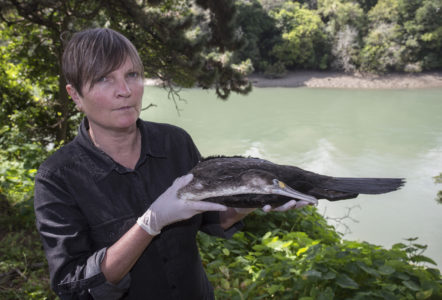
The starved body of a young pied shag is a harsh reminder that Auckland’s only suburban pied shag colony is dwindling.
The shag was pulled out of the Panmure Basin, where they have nested and lived for years, on Sunday afternoon during a planned clean up of the Tamaki Estuary.
Corina Hooper, a member of the Tamaki Estuary Protection Society, says overfishing has taken the pied shag colony from more than 150 breeding pairs 20 years ago, to only five breeding pairs today.
Hooper says the lack of food has left the shags, which feed by swimming underwater and searching for fish, needing substituted food to survive.
“I used to feed 30 plus a day. At the moment on a good day I have only 10 [pied shags] waiting at my gate to be fed,” says Hooper who has been feeding the shags since NZ Bird Rescue Charitable Trust founder Pam Howlett passed away in 2010.
“You kill one and that’s the breeding pair dead. They’re not going to pair again. And the ones that are still breeding, their babies are dying because there is no food,” she says.
The conservationist says birds are forced to go after the fishermen’s bait, where they become entangled in fishing lines or injured by fish hooks.
“Then fisherman just cut the line, leaving the birds to either drown or fly up into the trees still attached to parts of the line where they get caught in the branches unable to escape.”
Overfishing is not the only way humans are harming the pied shag colony Hooper says, with rising pollution levels and mistreatment of the shags another huge threat.
Hooper says she has often found shags who have been hit on the head by fisherman who are scared the birds will bite them, and even birds which had suffocated from having their mouths taped shut.
Pied shags are a protected New Zealand native bird species and there are heavy fines for anyone who intentionally hurts or kills them.
The birds are distinguishable by their black and white feather and distinctive yellow hooked beak.
Hooper says she has approached council about banning fishing in the Tamaki Estuary, but says by the time bylaws are passed to enforce this, the colony will have died out.
“I want people to think, ‘do I really need to fish in the basin?’ For these birds this is their backyard..they can’t go anywhere else, but you can.”
Hooper says that if people insist on fishing in the estuary, she urges them to bring injured shags to her at Pam Howlett’s cormorant sanctuary where they can be saved.
She says there is still time to save the colony, but she’s going to need others to get on board.










